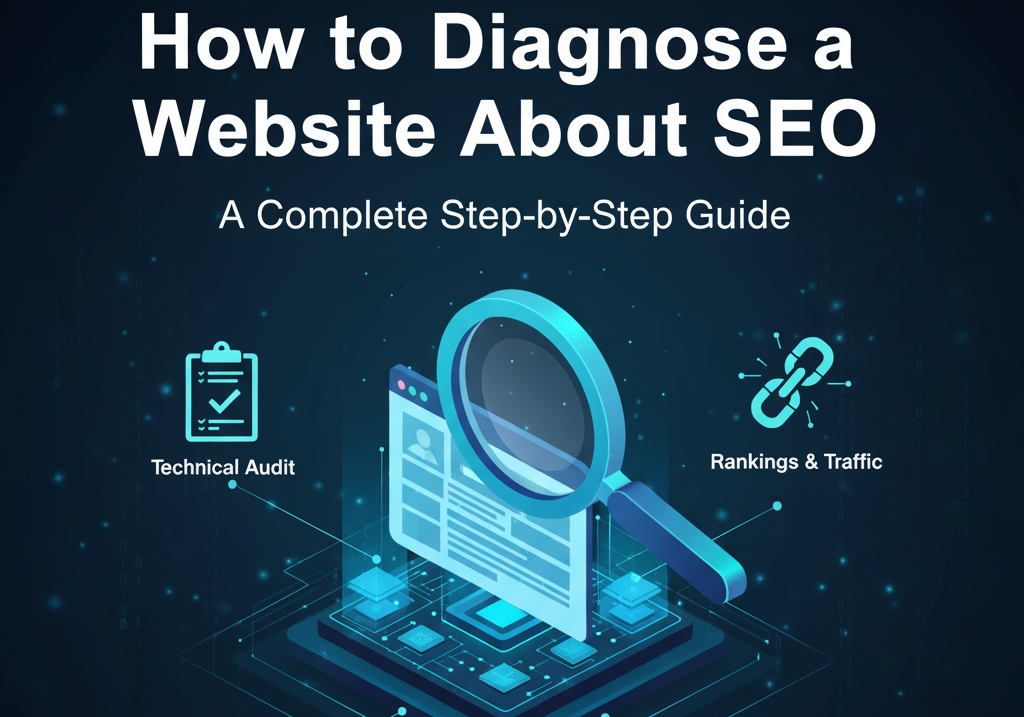In the current digital age it’s not sufficient. You need to have a site that is ranked. How do you know what’s wrong if your website doesn’t appear on the Google first page, or why traffic to your site is stagnant? How to Diagnose a Website About SEO?
Consider it like an annual health check-up for your site. It’s not like letting your car drive for hundreds of miles with no inspection, would you? That’s the same with your site. In this post we’ll explain how you can assess your website to determine its SEO step by step to help you identify the hidden problems, increase efficiency, and increase your rank.
Step 1: Check Your Website’s Loading Speed
The internet is a nightmare for slow sites, as do Google. If your site is taking more than three seconds to load your site, you could lose customers and ranking opportunities.
Tools for use:
- Google PageSpeed Insights (external authority)
- GTmetrix
- Pingdom Tools
Things to look at:
- Page loading time
- Core Web Vitals (LCP, FID, CLS)
- Image sizes
- Unused JavaScript and CSS
Speedier websites mean a more user satisfaction, plus greater conversions, and better SEO rankings.
Step 2: Analyze On-Page SEO Factors
The elements on your page send signals to Google regarding what the content refers to. The absence of or poor optimization of elements may hurt your SEO.
Verify for the following:
- Title Tags — are they optimized for SEO and have less than 60 characters?
- Meta Descriptions — effective and within 160 characters?
- H1 headings — one H1 for each page?
- Keyword Placement — keywords are normally included in headings and bodies?
- URL Structure — short, simple and word-based?
- Internal Links — do you link to other material (see our blog on how to build internal links for guidance)?
Although these small details could appear to be minor, they build a strong SEO base.
Step 3: Review Your Website Content
Search engines like information that’s useful, relevant and up-to-date. When your website’s content appears old or of poor quality, it’s the ideal time to revamp it.
Find your content’s flaws by asking:
- Are you able to answer the search queries of users?
- Are they informative, original and entertaining?
- Does it contain pertinent keywords (without stuffing)?
- Are you using photos, infographics or even videos?
- Are you running thin pages without much content?
Refresh older blogs with updated stats as well as keyword optimized headings in order to boost their exposure. Also check our blog on content refresh strategies for more ideas.
Step 4: Check Mobile-Friendliness
Utilizing mobile-first indexing, Google places your site’s rank by its mobile version. If your mobile site isn’t optimized, you’re in danger.
Make use of Google’s Mobile-Friendly Test tool.
Make sure:
- The design responds to user input.
- Fonts can be read on smaller screen sizes.
- Buttons can be clicked and are free of clutter.
- Navigating is easy and effortless.
A responsive site means an improved user experience as well as more prominent positions.
Step 5: Analyze Backlinks and Domain Authority
Backlinks (links to other sites) can be described as digital affirmations of your trust. Higher quality backlinks indicate more trust on Google.
Use tools like:
- Ahrefs
- SEMrush
- Moz Link Explorer
Look for:
- The number of backlinks
- Domain Authority (DA) or Domain Rating (DR)
- Links that are spammy or harmful
Avoid links that are harmful and establish credibility through guest posts and blog collaborations or by creating content that can be shared (check our post on effective backlink strategies to learn more).
Step 6: Inspect Technical SEO Issues
Technical SEO is the foundation of crawlability for your website. If search engines aren’t able to scan or index your website correctly, your rankings is likely to suffer.
You can verify these:
- XML Sitemap: Have you submitted it to Google Search Console?
- Robots.txt File: Have certain pages been blocked unintentionally?
- Broken Links (404 errors)
- HTTPS vs HTTP (SSL certificate)
- Canonical tags to stop duplicate information
- The proper use of schema markup (rich snippets)
A technical audit can ensure your site is properly optimised to be indexed by the search engines (see our article on technical SEO checklist for details).
Step 7: Evaluate User Experience (UX)
Google utilizes behavior indicators such as bounce rate, duration times, as well as click-through rate (CTR) to assess whether your site meets the needs of users.
Ask yourself:
- Are navigation and navigation easy and clear?
- Do CTAs (Call-to-Actions) appear?
- Does your layout look clean and professional?
- Do your visitors stick around on your website or leave fast?
Enhancing user experience results in more engagement and better rankings signals. Our blog on UX design for SEO explores this further.
Step 8: Track SEO Performance
When your diagnosis is confirmed after diagnosis, track your progress.
Use:
- Google Analytics for traffic & engagement.
- Google Search Console for performance and indexing problems.
- Tools for rank tracking (Ubersuggest, SEMrush) for keywords that rank.
The tracking tool helps you know if your SEO adjustments are working and the areas where you need to make improvements. Also explore our guide on SEO performance tracker setup for best practices.
3 Frequently Asked Questions (FAQs)
- What is the best way to check my website’s SEO?
Ideally, you’ll need to conduct an annual SEO check as well as a complete SEO check every three months in order to remain in front of your competitors. (Also see our article on SEO audit frequency.) - How can I identify my website issues with no paid software?
Yes! Utilizing free tools such as Google Search Console, PageSpeed Insights, Mobile-Friendly Test and Ubersuggest will help you pinpoint significant problems. - What is the most crucial aspect of SEO assessment?
Every part is important, however fixing technical glitches, increasing web speed and performance, as well as optimizing the content you publish should be first priorities.
Final Thoughts
The process of assessing your site’s SEO isn’t just a once-off task. It’s an ongoing procedure to ensure that your site is healthy in the eyes of search engines and competitive. It’s also about getting it to rank more highly. From testing speed and optimizing content to improving technical performance and analysing backlinks each stage plays an important impact on boosting your the visibility of your website.
Make your site … it’s a live machine, and requires frequent inspections, adjustments and upgrades to ensure it is performing the best it can. Get started with your SEO analysis today, correct your issues, and see your website’s rankings increase like ever before!
The faster you recognize the problem, the more quickly you will outsmart Google.







